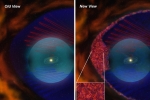Rjukan Sun Mirrors: Giant Reflective Contraption Redirects Sunlight To Norwegian Town During Dark Winters

In the small, heavily shaded Norwegian town of Rjukan, sun mirrors are being erected to bring light into the town.
Rjukan, a town of 3,000 people, doesn't receive any direct sunlight for seven months from September to March, as the Norwegian valley town is surrounded by high mountains that block the sun.
Like Us on Facebook
But now giant sun mirrors, attached to the very mountains that block the sun, will reflect rays down to the main square of Rjukan. Helicopters have helped secure the Rjukan sun mirrors into place.
The mirrors will be equipped with sensors to cause them to rotate along with the sun, for optimal ray-beaming throughout the day, a type of mirror known as a heliostat.
"The square will become a sunny meeting place in a town otherwise in shadow," says the Visit Norway webpage.
The idea of putting up sun mirrors in Rjukan is actually a rather old one. Some hundred years ago, the founder of a nearby hydroelectric plant, a famous Norwegian engineer named Sam Eyde, suggested erecting the sun mirrors. For technical reasons, the sun mirror project never got off the ground.
In 2006, the northern Italian town of Viganella, which suffers from the same sunlight problem as Rjukan, erected a similar sun mirror system. After a delegation from Rjukan visited Viganella, they made a plan for sun mirrors of their own.
After five years of debate, Rjukan town council finally agreed to invest the necessary 5 million Norwegian kroner (£544,000) to build the mirrors.
The Rjukan sun mirrors cost 5 million Norwegian kroner, or $830,000, and should be completed by July, with the mirrors in place well before the normally dark season.
© 2012 iScience Times All rights reserved. Do not reproduce without permission.

25 Year Study Reveals Eco-Farming To Be Economically Feasible And Sustainable

How Methane-Producing Microbes Caused The Largest Mass Extinction The World Has Ever Seen

Terrifying Animatronic Robot Dances To 'Blurred Lines,' Causes Nightmares [VIDEO]

Scientists Demonstrate Three-Way Quantum Communication: What's Faster Than The Speed Of Light?

Woolly Mammoth DNA To Be Cloned, Then Joined With Elephant DNA To Create New Creature

Oculus Rift Headset Will Take You On A Trip To Space, All From The Comfort Of Your Couch



![How to Turn Your Tap Water Faucet Into a Coffee Spout [VIDEO]](../../../cdn-sub/data/thumb/mainpage/6005-150100-coffee.jpg)

